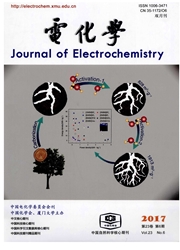

 中文摘要:
中文摘要:
在弱酸性因瓦合金(含镍质量分数为32~36%的镍铁合金)镀液中,以线性扫描伏安法、循环伏安法和恒电位阶跃法对因瓦合金在玻碳电极表面的电沉积过程及其成核机理进行研究.结果表明,在该体系下,因瓦合金在玻碳电极表面的电结晶属于扩散控制下的不可逆电极过程.运用Scharifker-Hills理论模型(SH)拟合实验数据表明,因瓦合金在玻碳电极表面的共沉积更加符合三维瞬时成核的成核规律.运用Heerman-Tarallo理论模型(HT)分析得到因瓦合金在玻碳电极表面的成核生长的动力学参数,当阶跃电位从-1.11 V变化至-1.17 V(vs.SCE),成核密度数(N0)由0.72×10^5 cm-2提高至1.91×10^5 cm-2,成核速率常数(A)从40.35 s-1增至194.38 s-1,扩散系数(D)为(7.67±0.15)×10^-5cm2·s-1,变化不大.
 英文摘要:
英文摘要:
The linear sweep voltammetry,cyclic voltammetry and potential step methods were used to study the electrodeposition mechanism of Invar nickel-iron alloy(the mass fraction of nickel was 32~36%) on glassy carbon electrode surface in the weak acidic bath.The results demonstrate that the electrodeposition was a diffusion controlled irreversible electrode process in this system.The Scharifker-Hill(SH) theoritic model was employed to fitting the experimental data and the result shows that the codeposition of Invar alloy on glassy carbon electrode surface conformed the diffusion controlled three-dimensional instantaneous nucleation mechanism.The kinetic parameters were obtained by the Heerman-Tarallo(HT) theoretic model.When the step potential shifted from-1.11 V to-1.17 V,the active nucleation sites density(N0) increased from 0.72×10^5cm-2 to 1.91×10^5cm-2.The nucleation rate constant(A) raised from 40.35 s-1 to 194.38 s-1 and the diffusion coefficient(D) was(7.67±0.15)×10^-5cm2·s-1,remaining basically constant.
 同期刊论文项目
同期刊论文项目
 同项目期刊论文
同项目期刊论文
 期刊信息
期刊信息
